Justinian
Justinian, also called "Justinian the Great", was an Eastern Roman emperor who ruled from 527 until his death in 565. He was extremely influential, whether in law and legislation, in the expansion of the Empire's borders, or his religious policies.

Justinian was also the funder for several important buildings, such as the Hagia Sophia, in Constantinople. His widely acclaimed Codex Iustinianus is a landmark in Law. He maintained trade routes all the way to China, which was dubbed the Silk Road. Much of this success was due to his wise and talented advisors, who were always called upon.
These advisors play a central role in today's game.
Let's get to know Justinian - Intrigue at the Emperor's Court!
Justinian - Game Info
Justinian - Intrigue at the Emperor's Court, or simply Justinian, is a 2-to-4 players game, age 10+, by designers Leo Colovini and Alessandro Saragosa. Art by Harald Lieske.

Justinian was released in 2006 by Phalanx Games. The main game mechanis are: bluffing and risk-taking.
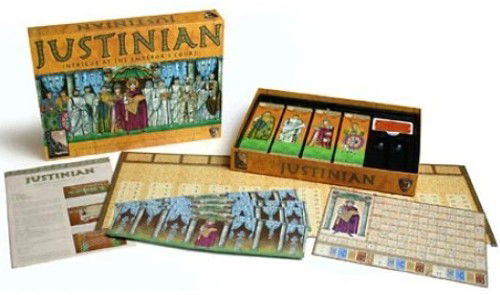
Let's play!
The Game
Emperor Justinian will summon his advisors at any moment. There are four different matters on the agenda, but only three of them will actually be discussed.
Which of these matters is the most important?
To decide which matter will be on the agenda and who will advise Justinian, you will need to bribe and manipulate the advisors and the court itself, ensuring that the advisors you trusted are well-positioned when summoned by Justinian. Manipulation, bribery, and influence, are at stake. Are you prepared?
This is the scenario for Justinian!
In Justinian, players start with 22 tokens to influence the advisor characters and the court. At the beginning of the game, you have only 10 of them at your disposal, as well as two random character cards in each of the four colors. These colors, in the game, represent the four matters that will be discussed with Justinian. Finally, during setup, the 12 characters are lined up in their positions.

A turn in Justinian has basically two possible actions:
- Action 1: use a token to influence the court's characters;
- Action 2: pass.
In Action 1, simply place one - and only one - of your influence tokens face down on one of the characters or on the court. The tokens' values range from 1 to 3, with black numbers being positive, and red ones negative.
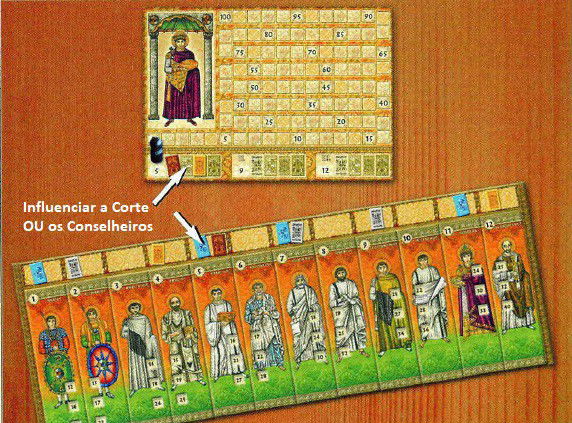
If you don't want to use any more tokens, or if you have none left, it's time to use Action 2, and pass. Passing allows you to take 2 new influence tokens from your reserve, and place them behind your player screen.
That's it! Any other players who haven't passed yet continue their current turn. It goes on until all players have passed, and therefore received 2 new influence tokens.
Now two important moments for the game happen:
- check the influence over the characters;
- whether or not the court will bring up any matter with the emperor.
The player who passed last in the round flips over the influence tokens that are face down and, based on their values, decides whether to adjust their positions from left to right, or right to left. This makes a big difference.
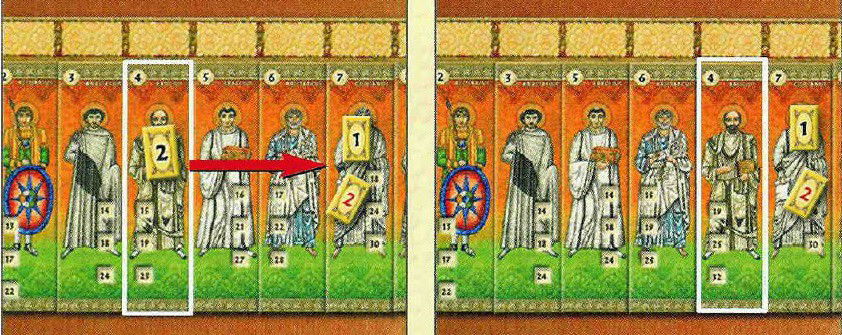
After making all the adjustments, another important decision must be made: whether or not someone can start a discussion of matters with the emperor. In game terms, it means that, starting with the last player to pass, they must decide whether or not to start a scoring round. If no one decides to open a scoring round, resume play and begin a new turn.
The fact is, for someone to want a scoring round, they must have placed a minimum number of tokens. However, even if they have enough tokens for a scoring round, they still don't know who'll decide which characters and colors will score, since the decision is made by the player with the highest number of influence tokens in the court chart.
So, in short:
- You need to have the required amount of influence in court to open a debate (scoring round);
- But, whoever has the most influence in court decides what matter will be debated (which color will score victory points).
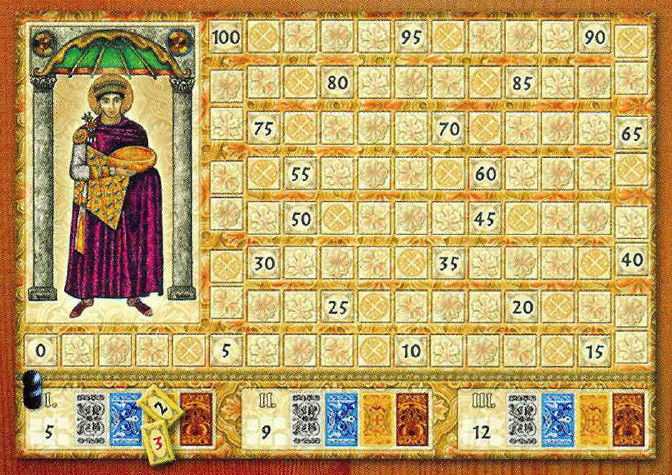
Even those who were unable to open a debate, or decide the matter on the agenda, still score points, as long as they have influence tokens placed in court. Of course, the majority of points, in theory, will go to the one with most influence, since they'll choose the matter to be discussed (the color that'll score points), and they'll of course choose the color where they have more characters better positioned.

As mentioned earlier, although the emperor has four matters to debate, only three of them will appear on the agenda throughout the game. Hence, it is important to:
- know the perfect timing to open a debate (scoring);
- decide which topic (color) will be scored based on your character cards in hand;
- decide whether you have influenced them enough to score well.
In the following example, the game is already in its second phase, meaning it will be scored based on the advisors' "middle hole". So, a player chose Blue as the matter for debate (scoring color), for which they had two well-positioned advisor cards in the court. Therefore, the player will receive 57 points.
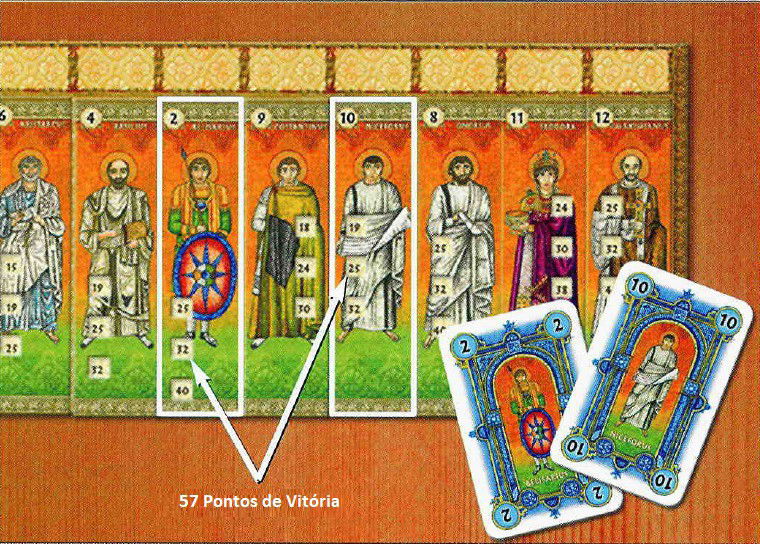
Following the previous example, once all players have scored their blue cards, before the next round begins, each player has the option to exchange one - and only one - of their character cards, starting with the player who passed last. You may put one advisor card from your hand at the bottom of the deck of cards in the same color, and draw a new one from the top.
That's a turn and a scoring round of Justinian!
Ending the game
The game ends when the third scoring round takes place, or when all players have no more influence tokens, at which point a final scoring round takes place.
At the end, the player with the most victory points wins!
Strategy Tips
Justinian is a game of influence, where bluffing is a powerful tool. Just placing an influence token says a lot about your strategy, namely:
- if you place an influence token in court, it may indicate that your advisors are already well-positioned to score points and you want to immediately propose a discussion (choose a color to score);
- if you place an influence token on a character, you may signal that you want them to be better positioned, or that you want them to lose prestige;
Or, in the end, you could just be bluffing all along.
I recommend always having influence in court, whether to be able to open a scoring round, or to be in a place to decide the scoring color, or to at least score a few points once the court is called.
The cool thing about the court is that its tokens don't have color differences; they simply add up. This is different from placing token on characters, where a black number means a positive value, and a red number means a negative value. This gives you opportunities to use any of your tokens with ease. For example, when your advisors are already well-positioned, and you have many negative tokens, you can just place them in court, since they'll add up anyway.
There is a maximum number of tokens on each character, which is 3. So, if you want to influence a character, don't overthink it:
- place positive-value tokens on the character you want to be better placed in court;
- place negative-value tokens on the character ahead of the one you want to be better placed.
By doing this, no one will know which strategy you're up to: are you aiding an ally or undermining a competitor? Remember, bluffing is part of the game.
Being the last to pass is important, as you'll be the one revealing the influence tokens, and you'll be able to choose the direction which the positions will be adjusted, from left to right, or right to left. This takes a little thinking, but it really matters.
Let's look at an example: characters 4 and 7 received influence tokens; the choice to adjust positions from left to right, or right to left, yields different results.

If you adjust the influence from left to right, you have the following result:
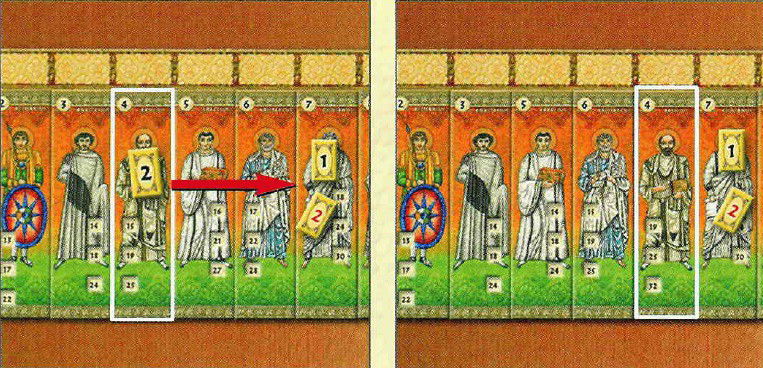
After adjusting character #4, now it's time to adjust #7:
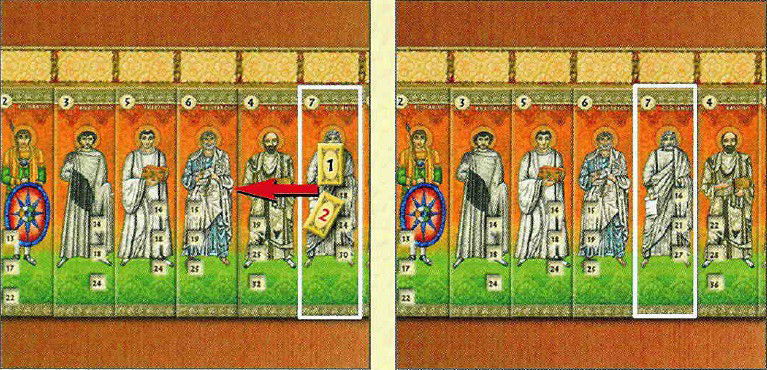
So, the final order of the characters ends up being:
- 1, 2, 3, 5, 6, 7, 4, 8, 9, 10, 11, and 12.
However, if the positions were to be adjusted from right to left, then the end result would be:
- 1, 2, 3, 5, 7, 4, 6, 8, 9, 10, 11, and 12
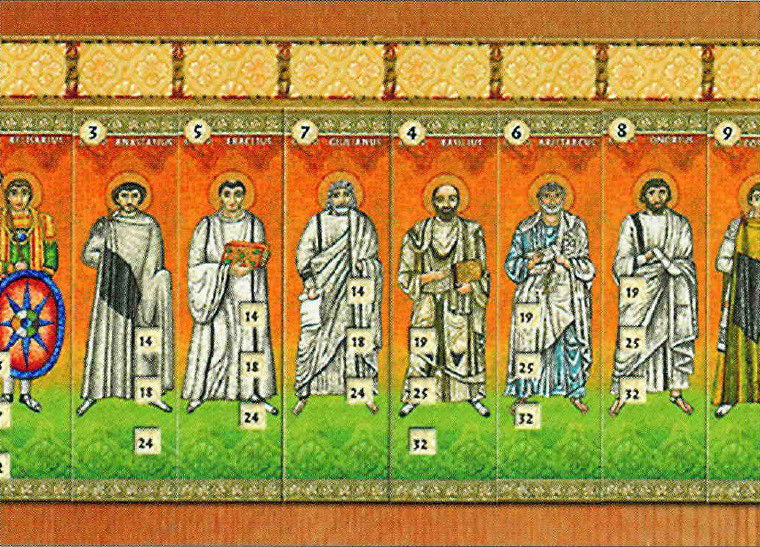
Note that Character #7 ends ahead of Character #4 in both situations, but from right to left, Character #6 moves up 2 tiles. That is, if you have a #6 card, starting from the right makes perfect sense. So, choose carefully which direction you'll start the adjustments.
Of course, being the last to pass also allows you to be first to decide whether or not to open a scoring round. Furthermore, if you have a good amount of influence in court, you'll also decide the matter that will be on the agenda (the color that will be scored). Worst-case scenario, if someone placed a higher amount of influence than you, you'll still get a lot of points.
Based on these tips, develop your best strategy, use your influence at the right time, and win in Justinian!
Overview and Rules videos
Overview:
Rules:
Pedagogical Tips
Justinian is an easy-to-explain, simple-to-play, yet highly strategic game, offering a history lesson and excellent stimuli for children.
I recommend starting the game by talking a little about Justinian's historical period and contextualize the children. Who were the characters, how the court worked, their influences, and so on. After this, once they see the game board and the 12 characthers in place, it will make perfect sense.
They'll immediately realize that the cards in their hands are the ones they want to be on the right, meaning they'll score the most points. Then the fun begins, as you place the hidden influence tokens, and the giggling starts—from the bluffing, and the surprises.
It's also noticeable that logical-mathematical reasoning comes into play. Simple calculations are necessary to estimate where your character will be placed. Spatial awareness also comes into play, as it's necessary to understand where each character can generate the most points, and how to get them to that tile on the board.
Strategy will always be present, in the moments between placing an influence token on the court, or on a character. Help them at the beginning and, over time, allow them to understand the best timing for each situation.
Pedagogically, Justinian encourages strategy, management, decision-making, logical-mathematical reasoning, spatial awareness, and it's fun!
I recommend Justinian for your collection!!!








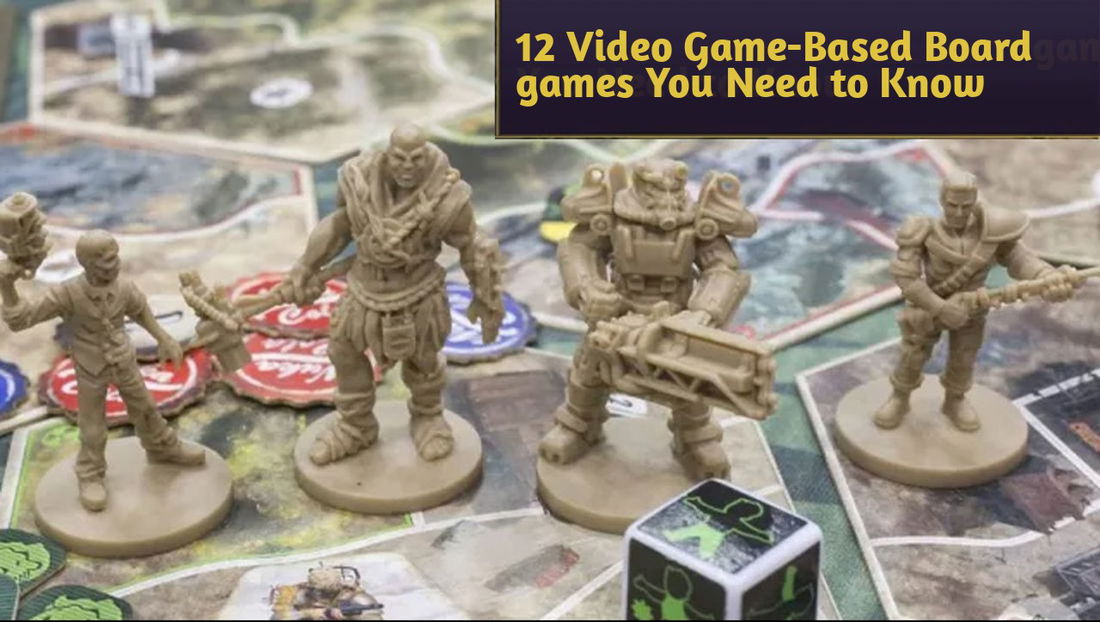



— Commenti 0
, Reazioni 1
Diventa il primo a commentare